ipad

[ The final touch in creating the world’s best company ]
Commissioning Norman Foster for Apple’s HQ may be Jobs’ perfect, grandiose, finishing touch to building the world’s best company. For years Apple’s design perfection has been visible at every scale from headphones to the monumental, crystaline, Kaaba that is Apple’s flagship store on 5th Avenue, but the Apple campus itself has been a visible let down. The ‘Apple Core’ has the opportunity to be its superlative product, because Jobs has picked the architect that is in many ways his spiritual twin and whose career has invisibly skirted and influenced Apple for more than a decade, its disc shaped design is where the stories of two of the world’s greatest design influencers comes full circle, literally.

[ Perfect Credentials, Norman foster with Buckminster Fuller ]

[ Apple’s Core The design images will probably be less ‘cheesy’ than this once it gets through the planners ]
Above all Jobs’ legacy at Apple has been about design. But it has clearly also been about business. Creating the worlds largest company, from one that Michael Dell rather disingenuously said he should shut down and give the money back, is a hardly an historical footnote. The business side of design is tricky to combine with its artistic one and design businesses are not usually scalable if they are too ‘arty’. The most successful architects, such as SOM in the 60s created a style that appealed to big businesses, via an aesthetic that matches, say, a bank, because banks traditionally needed expensive, well made looking buildings rather than the latest intellectual ‘ism’ that passed through architecture schools, in order to convey an image of stability and security.
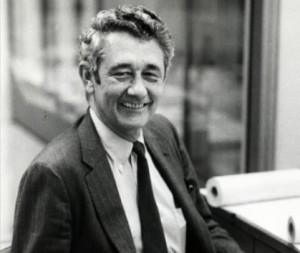
[ SOM’s Bruce Graham Foster took Graham’s American version of modernism back to Europe and Apple are re-re-importing it. Confused? ]
The design of a bank is what made Norman Foster. After returning to Britain from Yale, he was inspired by American modernism and SOM in particular and re-imported modernism back into Europe via a style that was compatible with business, High-Tech. Foster made High Tech an art form, and designed a series of beautiful sheds, everything from houses to offices to art galleries with the physical form of a hangar but the sophistication of a jet fighter.
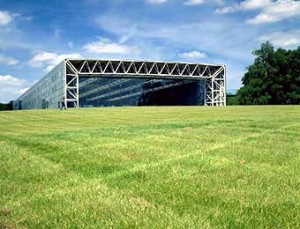
[ Foster’s Sainsbury Center, 1977. A beautiful shed, the physical form of a hangar with the sophistication of a jet fighter ]
His big break came when a bank, HSBC, commissioned him to design their Headquarters in Hong Kong, with the simple but historic brief to build the world’s best building. I joined the practice shortly after the Hong Kong Shanhai Bank HQ was finished and it was clear that the company was experiencing the kind of rapid growth that is more characteristic of the technology startups that I later worked for in the Bay Area. But the culture of Foster and Partners (as it was then called) was different from firms in Silicon Valley with one notable exception – Apple, the place that combined geek business inventiveness without its reputation for poor aesthetic sensibility. Perfecting the model of selling design that is compatible with big business, Foster simultaneously grew one of the largest architecture practices in the world while still winning awards for design excellence. The secret was to design buildings like the limited edition, invite only Porsches that Foster drove and fellow Porsche drivers would commission them.

[ Foster made buildings and Apple made computers like Porsche made cars ]
Jobs went further, however, he managed to create products that were designed like Porsches and made them available to everyone, via High Tech that transcended stylistic elements. An Apple product really was high technology and its form followed function, it went beyond the Porsche analogy by being truly fit for purpose in a way that a Porsche couldn’t, being a car designed for a speed that you weren’t allowed to drive. Silicon Valley capitalism had arguably delivered what the Soviets had dreamed of and failed, modernism for the masses. An iPhone really is the best phone you can buy at any price. To paraphrase Andy Warhol: Lady Gaga uses an iPhone, and just think, you can have an iPhone too. An iPhone is an iPhone and no amount of money can get you a better phone. This was what American modernism was about.

[ An iPhone is an iPhone and no amount of money can get you a better phone ]
The idea of American modernism for the masses arose from an ideology that was the opposite of the European one, the ideology of extreme individualism that epitomizes Silicon Valley, libertarianism, a watered down version of the kind of stuff that Nietzsche wrote about. Steve Jobs may or may not be a libertarian but his story and Foster’s and of uncompromising design are an intrinsic part of the culture that has emerged at the heart of the Mecca of technology and which defines it.
The image of the architect in the vein of Nietzsche superman is epitomized in Ayn Rand’s Nietzsche-light novel, the Fountainhead which depicts a modernist architect who struggles for success by being utterly uncompromising. There is even a Fountainhead-like novel directly inspired by Foster. Philip Kerr adapted Foster as the thinly disguised lead character of his high-tech thriller Gridiron which depicts the designer as a selfish monster who is crushed to death by his own building.
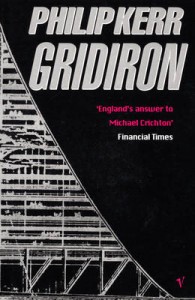
[ Gridiron – The Fountainhead with a Norman Foster based protagonist ]
If you speak to people who work for Jobs or Norman Foster the rumors that circulate would seem to hold up this idea of an Ayn Rand style control freak. That Steve simply cannot ever, ever let it drop as regards Gizmodo publishing the leaked iPhone 4, an ultimately trivial event that had as large an impact on the Twitto-blogosphere as a revolution or Coup D’Etat or that Norman fired someone on the spot after specifying the wrong door handle (not by Elementer), something that is literally akin to a Fountainhead. But these rumors are just that, they are to some extent what people want to believe as much as what they pretend not to want to glorify, that the boss wears black leather gloves and sits in a room full of shark tanks stroking a white cat, like a diabolical Bond villain.
The truth is more complicated, Foster and Jobs perhaps distance themselves from personal relationships with their employees in the way that does enable a certain amount of ruthlessness but perhaps this is proof that the human side exists. Foster grew up poor, loved his wife who died of cancer more dearly than anything in the world and adopted a friend of his son’s to give him a better life. Jobs was himself adopted, has suffered and battled heroically against his own cancer and has championed what matters in life beyond material wealth as eloquently as anyone, most notably in his Stanford Commencement speech.
[ Steve Job’s iconic 2005 Stanford Commencement Speech – have a dream ]
Apple appears to operate in a similar model to an architectural practice and Jobs’ involvement seems similar to the mode in which Foster operates. In a big organization the leader cannot do everything, so needs to delegate and this is achieved through a hierarchy and chain of command. But in a model which is based on creativity and attention to detail, how do you see the details if you are miles away from them at the top of a hierarchy. How do you keep control over the design of the fountainhead or the door handles or the color of the headphones?
The answer is what might be called the sand pile model and it operated at Apple and Fosters, the boss sits independently from the structural hierarchy, to some extent, and can descend at random on a specific element at will. The boss maintains control of the overall house style by cleaning up the edges at the same time as having a vision for the whole, like trying to maintain a sand pile by scooping up the bits that fall off as it erodes in the wind. This is the hidden secret of design firms or prolific artists, the ones where journalists or historians agonize whether a change in design means some new direction when it just means that there was a slip up in maintaining the sand pile. For example, there was an architecture competition entry from Foster that the Guardian Architecture critic thought represented a new style, when the reality was that Foster was on vacation when the office produced it, the first time he saw the design was on the private jet he took to present it.
So does that mean that Foster is a fraud – absolutely the reverse. This is the exception, as they say, that proves the rule. The absolutely stupendous thing is that Foster managed to maintain a level of artistic integrity by being involved in so much of the artistic output of the office by popping up randomly and quizzing unsuspecting employees about what they were doing. This is where the ‘getting fired over the wrong door handle’ myth comes from, and it parallels the accounts of Jobs at Apple where Steve Jobs’ hand written notes passed to a blog editor about his website design on the iPad create the myth of god like omnipresence because they assume that Jobs is present for all involvement like this all the way up the hierarchy. This myth creates the impression that Jobs is author of absolutely everything Apple.
Its a flaw of human nature to assume that revered individuals are authors of everything they touch. When historians argue over whether a Rembrandt is authentic, they miss the point, no Rembrandt was truly authentic, they were painted by a team that included Rembrandt himself to a greater or lesser degree, to maintain the house style. And there is one great anecdote that nails this myth of authorship – the famous Walt Disney signature. Walt Disney had really bad handwriting and someone else in the office created the recognizable version. When stills from Snow White were auctioned those that bore his actual signature fetched less than those with the iconic one. True authorship is a myth and this applies to Jobs.
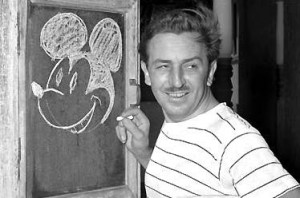
[ Disney had Mickey Mouse hand writing, his signature wasn’t his ]
The influence of Foster on Apple’s design goes beyond the abstract, the core elements of the Apple stores themselves lead indirectly to several famous architects but Foster in particular. The 5th Avenue store owes more to IM Pei’s Louvre pyramid for example, but its a later version of the prototypical version which is best represented by the first Manhattan one in Soho. The Soho store is a box with a central rooflit void containing a translucent glass stair. This is an identical description of Foster’s Mediateque in Nimes in France where such glass stairs were perfected.
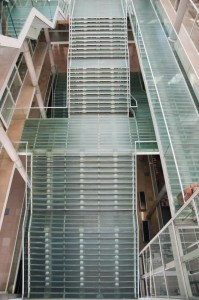
[ Foster’s Mediateque in Nimes, 1993, which perfected the glass staircase that became the iconic component of Apple stores ]
Foster is at his best creating buildings that exist as perfect diagrams, the Sainsbury center is a bubble chamber, a U-shaped tunnel with an oblique entry and a spiral, the Reichstag is an inversion of oppressive classicism, an open fishbowl for a new democracy and Stanstead is an attempt to put all the crap in an airport out of sight to create an airport that contains mostly air. The less good buildings, such as the Gherkin which are part of the Dubai influenced trend of funny shaped towers with rather ordinary floor plans weren’t really designed by him (Ken Shuttleworth was primarily responsible for the Gherkin), and as he moved to Nyon a few minutes away from where I live, near Geneva, perhaps Foster is no longer as involved in the London based firm’s designs. But I hope that with the Apple campus he is, it’s a perfect diagram, a squashed glass Apple the size of a town and with a layout like Burning Man. Unlike the Gherkin and despite what people say for the benefit of planners (it’s a giant spaceship) the shape isn’t that unusual or important, but its simple enough to allow for the attention to detail, in beautiful, giant curved glass swathes, that epitomizes Apple.

[ A squashed glass Apple the size of a town and with a layout like Burning Man ]
It would be a fitting cap to an illustrious career and the achievement of a long term goal that Fosters never quite pulled off (even if you include the Hearst Tower in NY) to re-import his quintessentially American style from Europe, repeating what Jonathan Ive did for product design under Jobs, and to produce something that becomes an American cultural landmark, something which Silicon Valley lacks.